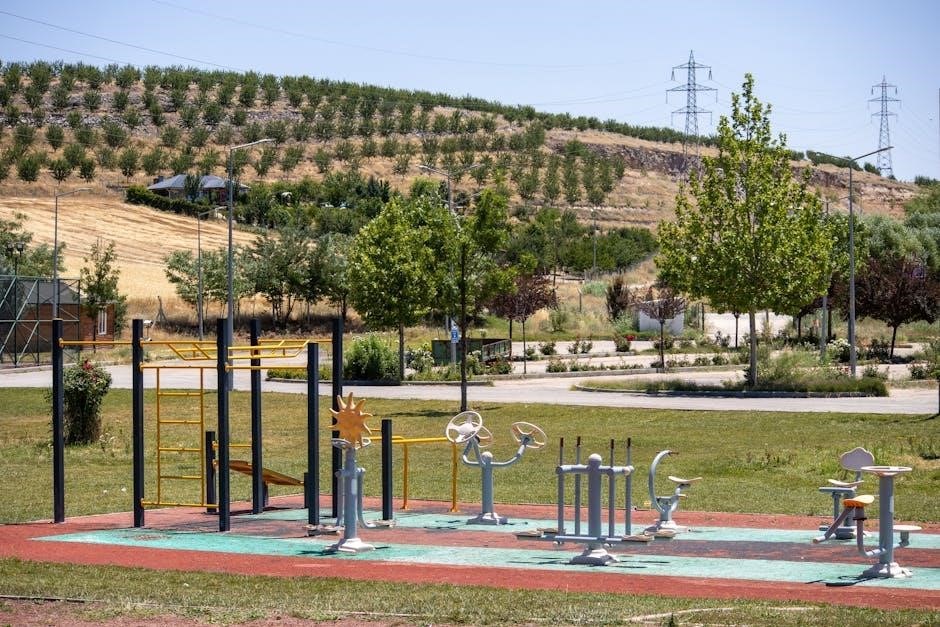Andrea Gibson’s “Letter to the Playground Bully” is a powerful spoken word poem written from the perspective of an 8-year-old, addressing bullying with raw emotion and resilience, offering empowerment through words and understanding of the bully’s possible pain, part of the album “Flower Boy,” available as a PDF for readers seeking inspiration and reflection on self-worth and societal impact.
1.1 Overview of “Letter to the Playground Bully”
Andrea Gibson’s “Letter to the Playground Bully” is a poignant spoken word poem written from the perspective of an 8-year-old girl addressing her childhood bully. The poem explores themes of bullying, self-worth, and empowerment, using vivid imagery and figurative language to convey the emotional impact of harmful words. It also invites reflection on the bully’s possible motivations, suggesting inner pain or insecurity. Part of Gibson’s album Flower Boy, the poem is celebrated for its raw emotion and resilience, offering a powerful message of hope and understanding.
1.2 Andrea Gibson’s Background as a Spoken Word Poet
Andrea Gibson is a renowned American spoken word poet, activist, and queer advocate known for their raw, emotional, and thought-provoking performances. Gibson gained prominence through their unflinching exploration of themes such as social justice, gender identity, and personal resilience. Their work often blends lyricism with sharp political commentary, resonating deeply with diverse audiences. As a prominent figure in the spoken word movement, Gibson has been featured on platforms like Button Poetry and has authored several celebrated collections, solidifying their reputation as a powerful voice for marginalized communities and social change.
1.3 Historical Context of the Poem
“Letter to the Playground Bully” is part of Andrea Gibson’s 2011 spoken word album, Flower Boy, which gained widespread recognition for its raw exploration of bullying, identity, and resilience. The poem reflects Gibson’s personal experiences and broader societal issues of the time, such as the rise of anti-bullying movements and increased visibility of LGBTQ+ rights. Written from the perspective of an 8-year-old, it captures the vulnerability of childhood, resonating with audiences amid growing conversations about mental health and empathy. The poem remains a cornerstone of Gibson’s work, highlighting their ability to address universal struggles through deeply personal narratives.

Themes and Messages in the Poem
The poem explores themes of bullying, self-worth, and empowerment, urging understanding of the bully’s perspective while highlighting resilience and the transformative power of words in overcoming adversity.
2.1 The Impact of Bullying on Self-Worth
The poem vividly portrays how bullying erodes self-worth, especially in childhood, as harsh words become weapons that scar deeply. Gibson, writing as an 8-year-old, captures the pain of being targeted, showing how such experiences can make victims question their value and identity. The poem highlights the lasting emotional toll of bullying, emphasizing how it can shape a child’s perception of themselves and the world around them, making it harder to regain confidence and self-acceptance in the face of such trauma.
2.2 Empowerment Through Words
Andrea Gibson’s poem masterfully illustrates how words can be both weapons and tools for empowerment. By addressing the bully directly, the speaker challenges the power dynamics, transforming pain into resilience. Gibson’s use of imaginative language, such as “cartwheels in your mouth” and “words growing up to be gymnasts,” flips the narrative, turning hurtful words into a source of strength. This poetic approach not only affirms the victim’s worth but also highlights the potential for words to heal and uplift, offering a powerful counterpoint to the destructive impact of bullying.
2.3 The Perspective of the Bully
Gibson’s poem offers a unique insight into the bully’s mindset, suggesting that their actions stem from personal pain or insecurity. By imagining “cartwheels in your mouth” and “words growing up to be gymnasts,” the speaker implies that the bully’s harshness may be unintentional or a reflection of their own struggles. This perspective humanizes the bully, encouraging empathy rather than hatred; Gibson’s approach challenges the binary of victim and aggressor, fostering understanding and highlighting the complexity of human behavior in the context of bullying.
2.4 Societal Norms and Identity
Gibson’s poem critiques societal norms that marginalize individuals, particularly those perceived as different. The speaker’s experience reflects the broader impact of societal pressures on identity formation. By addressing the bully, the poem subtly challenges norms that perpetuate exclusion and harm. Gibson’s use of metaphor, such as “rocks in their voice boxes,” highlights how societal expectations can silence or distort self-expression. The poem advocates for a world where individuals, especially children, can embrace their authentic selves without fear of judgment or rejection, fostering a more inclusive and compassionate society.

Structure and Style of the Poem
The poem employs vivid imagery, repetition, and rhythm to convey emotional depth. Gibson’s use of metaphors, such as “cartwheels in your mouth,” creates a unique, evocative style, blending innocence with profound insight, part of the album “Flower Boy,” available as a PDF for deeper exploration of its lyrical and structural brilliance.
3.1 Use of Figurative Language
Andrea Gibson masterfully employs figurative language in “Letter to the Playground Bully,” using metaphors like “cartwheels in your mouth” and “words growing up to be a gymnast” to explore the bully’s potential inner pain and the power of words. Her imagery vividly contrasts innocence with hardship, while personification and repetition emphasize the emotional weight of bullying. These literary devices create a poignant and evocative narrative, allowing readers to connect deeply with the poem’s themes of self-worth and resilience.
3.2 Repetition and Rhythm
Andrea Gibson’s use of repetition and rhythm in “Letter to the Playground Bully” enhances the emotional impact of the poem. The repeated use of “maybe” creates a rhythmic flow, emphasizing the exploration of the bully’s motivations. The poem’s spoken word nature relies heavily on rhythm to convey raw emotion, with phrases like “maybe your words will grow up to be a gymnast” resonating deeply. This rhythmic structure aligns with the emotional tone, making the poem both engaging and memorable while reinforcing its themes of self-worth and resilience.
3.3 Imagery in the Poem
Andrea Gibson’s vivid imagery in “Letter to the Playground Bully” creates a powerful emotional landscape. Lines like “maybe there are cartwheels in your mouth” and “maybe your words will grow up to be a gymnast” paint a dynamic picture of transformation. The imagery of “rocks in their voice boxes” turning into “slingshots” underscores the lasting impact of unspoken pain. These metaphors not only highlight the bully’s potential inner struggles but also connect their actions to the deeper wounds they may carry, making the poem both evocative and thought-provoking.
3.4 The Role of Metaphors
Metaphors play a crucial role in “Letter to the Playground Bully,” transforming pain into poetic reflection. Gibson uses metaphors like “cartwheels in your mouth” and “words growing up to be a gymnast” to suggest the bully’s potential for harm or transformation. These metaphors humanize the bully, implying their harsh words may stem from inner turmoil. The metaphor of “rocks in voice boxes” becoming “slingshots” vividly connects unspoken pain to outward aggression, offering a layered exploration of both victimhood and the complexities of bullying, encouraging empathy and self-reflection in the process.

The Poet’s Perspective
Andrea Gibson writes from the heart, offering a child’s raw viewpoint on bullying, blending vulnerability with resilience. Her perspective humanizes the bully, suggesting their actions may stem from hidden pain, fostering empathy and self-reflection.
4.1 Writing from the Perspective of an 8-Year-Old
Gibson’s choice to write as an 8-year-old creates an intimate and innocent tone, allowing readers to connect deeply with the child’s pain and confusion. This perspective simplifies complex emotions, making the experience relatable and universal. By using a child’s voice, Gibson highlights the vulnerability and rawness of bullying’s impact, emphasizing how early such trauma can affect self-worth and identity. This approach also invites empathy, encouraging readers to reflect on their own experiences and the broader implications of bullying. The simplicity of the language underscores the profoundness of the message.
4.2 Personal Experiences of Bullying
Gibson’s poem draws heavily from her personal experiences of being bullied in school, infusing the text with authenticity and emotional depth. By addressing the bully directly, she confronts the trauma head-on, creating a sense of immediacy and raw honesty. The poem reflects her journey of processing pain and transforming it into a message of resilience. Gibson’s willingness to share her story fosters connection with readers who have endured similar struggles, making the poem both deeply personal and universally relatable. Her voice captures the vulnerability and strength of overcoming adversity.
4.3 The Poet’s Message to the Bully
Gibson’s message to the bully is one of unexpected empathy and understanding. She suggests that the bully’s harmful actions might stem from their own pain or insecurity, urging them to reflect on their behavior. Through lines like “maybe there are cartwheels in your mouth,” she offers a nuanced perspective, implying that their words could be instruments of both harm and transformation. The poem challenges the bully to consider the impact of their actions while acknowledging the humanity behind their cruelty, fostering a dialogue of mutual understanding rather than confrontation.
4.4 The Role of Empathy in the Poem
Gibson’s poem masterfully employs empathy to bridge the gap between victim and bully. By imagining the bully’s internal pain, she humanizes them, suggesting their hurtful actions may stem from personal suffering. Lines like “maybe there are cartwheels in your mouth” and “maybe your words will grow up to be a gymnast” illustrate how empathy transforms confrontation into understanding. This approach fosters a deeper connection, encouraging both parties to reflect on their actions and emotions, ultimately promoting healing and mutual comprehension rather than continued conflict. Empathy becomes a powerful tool for reconciliation and growth.

Key Lines and Their Interpretation
Iconic lines like “Maybe there are cartwheels in your mouth” and “Maybe your words will grow up to be a gymnast” highlight the poem’s themes of empowerment and reflection, exploring the bully’s potential pain and the lasting impact of words. These lines underscore Gibson’s unique ability to transform hurt into poetic insight, inviting readers to reconsider their perceptions of both victim and bully through vivid imagery and emotional depth. The imagery-rich language fosters a deeper understanding of the complexities of bullying and its effects on all parties involved, emphasizing the transformative power of empathy and self-awareness. The lines also serve as a metaphor for the ways in which words can either harm or heal, depending on their intent and delivery, challenging readers to think critically about the words they choose to use and the impact those words have on others.
5.1 “Maybe there are cartwheels in your mouth”
“Maybe there are cartwheels in your mouth” is a vivid metaphor exploring the duality of words as both playful and harmful. Gibson suggests the bully’s words might stem from inner pain, challenging the victim to see the bully’s humanity. This line invites empathy, urging reflection on the motivations behind hurtful actions; It underscores the transformative power of language, balancing harm and healing, and encourages understanding of the bully’s perspective while advocating for kindness and self-awareness in addressing conflict. This line captures the poem’s essence of turning pain into insight and fostering emotional growth.
5.2 “Maybe your words will grow up to be a gymnast”
“Maybe your words will grow up to be a gymnast” is a striking metaphor that highlights the dual potential of language. Gibson suggests that words can either bring joy and grace, like a gymnast’s performance, or cause harm. This line challenges the bully to consider the impact of their words, implying that they have the power to either uplift or wound. It emphasizes the transformative power of language and encourages reflection on how words are used. This poetic imagery underscores the poem’s themes of empowerment and the responsibility that comes with speech, urging mindful communication and self-awareness in addressing others.
“I know some people get a whole lot of rocking in the rocking chair” reflects on those who find comfort and ease in life, perhaps implying a lack of challenge or growth. Gibson contrasts this with those who do not, suggesting their silence or stillness may hide inner turmoil. This line subtly ties into the theme of societal norms and identity, where outward appearances can mask deeper struggles. The rocking chair serves as a metaphor for complacency, while the absence of rocking symbolizes unresolved pain, highlighting the poem’s exploration of internal and external conflicts and the complexities of human experience. “And the ones who don’t sometimes get rocks in their voice boxes” is a haunting metaphor that suggests those who don’t experience comfort or ease may internalize their pain. The “rocks” symbolize the weight of unspoken emotions, transforming their voice boxes into “slingshots.” This line highlights how unresolved trauma can manifest as outward aggression or silence, tying into the poem’s exploration of bullying and its cyclical nature. Gibson’s imagery underscores the lasting impact of pain and the struggle to express it, emphasizing the interconnectedness of suffering and behavior. “Letter to the Playground Bully” has garnered critical acclaim for its raw emotion and impactful message, resonating deeply with audiences and influencing anti-bullying movements, solidifying its place in Gibson’s celebrated body of work as a powerful advocate for resilience and empathy. Andrea Gibson’s “Letter to the Playground Bully” has received widespread critical acclaim for its emotional depth and powerful message. Reviewers praise its ability to resonate universally, offering a poignant reflection on bullying and self-worth. The poem’s raw honesty and innovative use of language have been highlighted as standout elements, making it a cornerstone of Gibson’s celebrated body of work. Its impact extends beyond literature, influencing anti-bullying movements and inspiring countless readers seeking empowerment and understanding. Andrea Gibson’s “Letter to the Playground Bully” has become a significant voice in anti-bullying movements, inspiring advocacy and fostering empathy. Its exploration of both the victim’s pain and the bully’s potential vulnerabilities has sparked conversations about the root causes of bullying. The poem’s message of resilience and understanding has been widely shared, resonating with educators and activists. By humanizing both sides, it encourages a deeper dialogue, making it a powerful tool for promoting kindness and inclusivity in schools and communities worldwide, contributing to a cultural shift in addressing bullying. Andrea Gibson’s “Letter to the Playground Bully” has gained significant popularity and cultural resonance, becoming a favorite in spoken word circles. Its emotional depth and unique perspective have made it widely shared and discussed, inspiring countless individuals to reflect on their own experiences with bullying. The poem’s message of resilience and empathy has transcended traditional literary audiences, reaching a broader cultural landscape. It has been featured on platforms like Button Poetry and is often cited as a defining piece in Gibson’s work, solidifying its place in contemporary poetry’s cultural consciousness. “Letter to the Playground Bully” holds a prominent place in Andrea Gibson’s portfolio, showcasing their ability to blend personal narrative with universal themes. As part of the album “Flower Boy,” it highlights Gibson’s signature style of raw emotion and poetic activism. The poem is often cited as a fan favorite and a pivotal piece in their discography, emphasizing their commitment to addressing social issues like bullying and identity. It exemplifies Gibson’s skill in turning vulnerability into powerful storytelling, solidifying their reputation as a leading voice in contemporary spoken word poetry. Andrea Gibson’s spoken word album Flower Boy (2011) features Letter to the Playground Bully, a poignant reflection on bullying and resilience, showcasing Gibson’s storytelling prowess and emotional depth. Flower Boy, released in 2011, marked a significant milestone in Andrea Gibson’s career, showcasing their unique voice and emotional depth. The album received critical acclaim for its raw honesty and powerful storytelling, resonating deeply with listeners. It solidified Gibson’s reputation as a leading figure in spoken word poetry, blending personal narratives with broader social themes. The album’s success highlighted the growing impact of spoken word as a medium for addressing trauma, identity, and resilience, making it a cornerstone of Gibson’s body of work. “Letter to the Playground Bully” stands out as a pivotal piece in Flower Boy, capturing the essence of childhood trauma and resilience. The poem’s emotional depth and unique perspective anchor the album’s themes of bullying, self-worth, and societal norms. Its raw honesty and metaphorical richness provide a foundation for exploring broader narratives of pain and empowerment, making it a cornerstone of the album’s emotional journey and a testament to Gibson’s storytelling prowess. In addition to “Letter to the Playground Bully”, the album Flower Boy features several other compelling poems that highlight Andrea Gibson’s storytelling prowess. Poems like “I Sing the Body Electric” and “Your Life” explore themes of identity, love, and societal expectations, resonating deeply with listeners. These works, alongside the title track “Flower Boy”, collectively create a powerful narrative of vulnerability, hope, and resilience, showcasing Gibson’s ability to weave personal and universal truths into their poetry. Flower Boy has significantly influenced the spoken word genre, showcasing Andrea Gibson’s unique ability to blend raw emotion with lyrical precision. The album’s intimate delivery and unflinching honesty have inspired many poets, particularly in addressing themes like bullying, identity, and resilience. Its success has also highlighted the power of spoken word to connect with audiences on a deeply personal level, making it a landmark work in contemporary poetry and a testament to the genre’s enduring impact and relevance in modern storytelling. Download Andrea Gibson’s poem as a PDF for a powerful read, exploring raw emotion and resilience. Available on platforms like Button Poetry and other literary sites. The PDF version of Andrea Gibson’s “Letter to the Playground Bully” can be downloaded from platforms like Button Poetry and other literary websites. It is also available on Google Books and Amazon as part of Gibson’s spoken word album, Flower Boy. Additionally, the poem can be accessed through academic databases and poetry forums, offering readers a convenient way to explore its powerful message and emotional depth. These resources provide easy access for fans and scholars alike. For deeper understanding, analyses of Andrea Gibson’s poem can be found on platforms like Button Poetry and academic databases. Literary websites and educational forums offer insightful interpretations, exploring themes like bullying and empowerment. YouTube channels and blogs also provide video discussions and written critiques. These resources are invaluable for both casual readers and scholars, offering a rich exploration of Gibson’s unique style and emotional depth in “Letter to the Playground Bully.” Andrea Gibson’s work includes poems like “Your Life” and “A Boy Named Andrew,” which explore themes of identity, resilience, and societal challenges. These poems, like “Letter to the Playground Bully,” are known for their emotional depth and empowerment. Gibson’s poetry often addresses personal struggles and broader social issues, making their body of work a compelling exploration of human experience. Fans of “Letter to the Playground Bully” will find similar resonance in these related poems, available in their albums and published collections. Scholars and critics have extensively analyzed “Letter to the Playground Bully,” exploring its themes of bullying, empowerment, and identity. Academic essays highlight Gibson’s unique perspective and use of figurative language, while critical reviews praise the poem’s emotional resonance. The poem is often studied in gender studies and education courses, emphasizing its relevance to societal norms. Essays also discuss its impact on anti-bullying movements and its role in Gibson’s broader body of work. The PDF version of the poem is widely used in academic settings for its accessibility and depth, making it a key resource for researchers and students alike. “Letter to the Playground Bully” leaves a lasting impact, offering empowerment and empathy. Its exploration of bullying, self-worth, and societal norms remains deeply resonant, ensuring its timeless relevance and emotional power through Gibson’s poignant words, available in PDF for further reflection and study. “Letter to the Playground Bully” delivers a profound message about the emotional toll of bullying and the transformative power of empathy. Gibson challenges the bully while acknowledging their potential pain, suggesting hurtful words may stem from insecurity. The poem emphasizes resilience, encouraging victims to find strength in their voices. It also critiques societal norms that perpetuate harm, urging understanding and compassion. Through vivid metaphors and raw emotion, Gibson advocates for healing and empowerment, leaving a lasting impact on readers and listeners alike. “Letter to the Playground Bully” has left an indelible mark on both literary and social landscapes. Its exploration of bullying, empathy, and resilience continues to resonate deeply, inspiring countless readers and listeners. The poem’s ability to flip the narrative, humanizing both victim and bully, has sparked crucial conversations about kindness and understanding. Featured in the album Flower Boy, it remains a cornerstone of Gibson’s work, influencing anti-bullying movements and empowering individuals to confront pain through art. Its legacy endures as a powerful call to action and healing. “Letter to the Playground Bully” stands as a testament to the transformative power of poetry. Gibson’s nuanced exploration of bullying, identity, and empathy offers readers a profound reflection on human experience. By giving voice to both victim and aggressor, the poem challenges societal norms and fosters understanding. Its accessibility and emotional depth have made it a cherished piece in Gibson’s body of work, ensuring its relevance for future generations. This poem is not just a critique of bullying but a celebration of resilience and the enduring impact of compassionate words.5.3 “I know some people get a whole lot of rocking in the rocking chair”
5.4 “And the ones who don’t sometimes get rocks in their voice boxes”

The Poem’s Reception and Legacy
6.1 Critical Acclaim and Reviews
6.2 The Poem’s Influence on Anti-Bullying Movements
6.3 Popular and Cultural Impact
6.4 The Poem’s Place in Gibson’s Body of Work

The Spoken Word Album “Flower Boy”
7.1 The Album’s Release and Reception
7.2 The Role of “Letter to the Playground Bully” in the Album
7.3 Other Notable Poems from the Album
7.4 The Album’s Contribution to Spoken Word Poetry

Resources and Further Reading
8.1 Where to Find the PDF Version of the Poem
8.2 Recommended Analysis and Interpretations
8.3 Related Poems by Andrea Gibson

8.4 Academic and Critical Essays on the Poem
9.1 Summarizing the Poem’s Key Messages

9.2 The Lasting Impact of “Letter to the Playground Bully”
9.3 Final Thoughts on the Poem’s Significance
